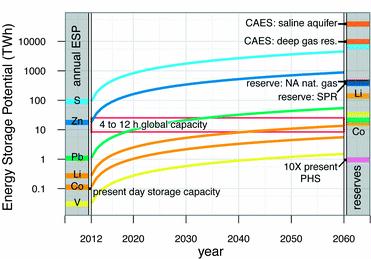Fig. 4 shows the ESP for grid-scale storage technologies. The shaded section on the left shows the ESP for EES limiting materials based on their annual production (colored bars). Using Pb as an example, if the entire annual production of lead was used to create PbA batteries, the total energy storage capacity would be 1.1 TW h or about 2% of the average world daily electricity demand. Sulfur, if used entirely for NaS manufacturing, would yield nearly 1000 times greater energy storage capacity. The main section of Fig. 4 shows ESP as a function of time (x-axis) assuming linear growth. This provides an estimate for the time required for a storage technology to reach an energy storage capacity goal of 4 to 12 hours (red horizontal lines). The shaded region on the right shows ESP as a function of economically viable reserve estimates or as a function of conducive geologic formations. Traditionalfossil fuel storage reserves are shown as reference (see footnote‡).
Utility scale energy storage doesn’t scale up: limits to minerals and geography

